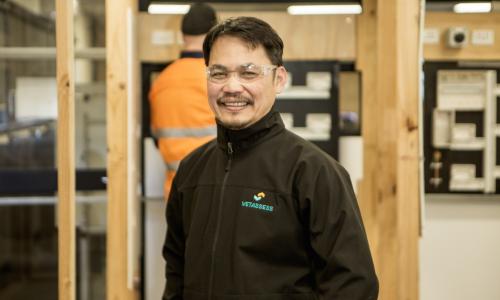Many Australian industries are struggling with staff shortages but one of the most dire needs is in aged care. Qualified workers from India can help fill the skills gap.

By Rob Thomason
Many Australian industries are struggling with staff shortages but one of the most dire needs is in aged care.
Care homes are being forced to close because owners cannot find skilled staff to meet staffing requirements, and the outlook is bleak. The nation faces a shortage of at least 110,000 aged care workers by 2030 according to the Committee for Economic Development of Australia (CEDA).
One solution is to allow employers to hire staff from abroad and in May 2023 the Australian Government allowed employers to sponsor overseas workers through Aged Care Industry Labour Agreements.
Discussions between VETASSESS and India’s National Skill Development Corporation, a partnership between the Indian Government and private sector, indicate there is a ready supply of qualified workers from India willing to travel to Australia to work.
Indian nurses would welcome the opportunity work in Australian aged care facilities.
Training Indian workers for Australian workplaces
Specialised training can be provided so that qualified migrant workers arrive understanding the culture and requirements of Australian workplaces.
This is proving successful in Britain where UK firm Indago conducts training in India that gives nurses the information they will need when they arrive.
Indago Senior Faculty Trainer Jason Carder says the training covers regulated care in the UK, equipment and how facilities operate, and it also deals with language used, training in mental health, advanced dementia approaches and the emotional needs of residents.
The program is approved by Britain’s National Health Service and is recognised for the quality of its training in empathy.
Mr Carder says appropriate training gives workers the knowledge they need to arrive ready to work and the confidence to prosper in the role.
Indago’s partner in India is Ed2Careers, which identifies suitable staff and provides training to social care workers.
Founder Geetanjali Alamshah says proper integrity checks and training in soft skills can allay employer concerns about cultural differences between migrant workers and care residents.
She recently visited Australia to meet care providers here and says Indian nurses want to move to Australia to work, citing the quality of life, schools for their children, and because they feel healthcare workers are treated with dignity and respect.
“They are very qualified, very talented and very dedicated nurses,” she said.
Why are Indian workers encouraged to move to Australia?
While Australia has an ageing population, more than 40 percent of India’s population is aged under 25. Competition for jobs is fierce.
The Indian Government encourages skilled international mobility and maintains links with the diaspora, believing the emigrants will gain new skills and connections that will be transferred back to India.
And Indian workers send money home. India is the world’s top recipient of remittances from non-residents, an estimated US$111 billion in 2022, according to the World Bank.
Filling Australia’s aged care skills shortage
By December 2023, 21 Aged Care Industry Labour Agreements had been signed and another four were awaiting approval from the Department of Home Affairs.
The agreements provide for up to 9,000 visas over the next five years. Minister for Immigration Andrew Giles says that while it is unlikely all of those positions will be used, the figure creates certainty for these providers.
The agreements are between the Department and individual employers and are structured to enable employers to find staff overseas when they cannot get appropriately qualified Australians, with provisions to protect foreign workers from exploitation.
The first 21 agreements are a start, but in terms of the industry they cover only 21 employers out of 1484 providers of residential and home care places nationally.
How to ensure aged care workers have the right skills
The agreements allow employers to sponsor overseas workers in three aged care occupations:
- Nursing Support Worker
- Personal Care Assistant
- Aged or Disabled Carer
Nurses from India would move into these roles and employers would gain qualified nurses with work experience.
VETASSESS and its partners would work to ensure prospective migrants had the education and experience required for the roles, and that any gaps in knowledge were identified and training provided.
Nurses would arrive with a greater understanding not only of the employer’s expectations and the Australian workplace, ensuring a smooth transition to work for both the employer and the migrant aged care worker.
Without migration, it is hard to see how Australian aged care providers can meet staffing requirements in aged care, and the staff shortage is set to worsen as the Australian population ages.
At VETASSESS we are initially looking at care labour agreements bringing skilled aged care workers from India, we could also use our networks to source workers from other countries.
Rob Thomason is Executive Director of VETASSESS
Sources:
Committee for Economic Development of Australia https://www.ceda.com.au/ResearchAndPolicies/Research/Health-Ageing/Duty-of-care-Aged-care-sector-running-on-empty
https://minister.homeaffairs.gov.au/AndrewGiles/Pages/speech-unlocking-the-potential-20112023.aspx
https://gen-agedcaredata.gov.au/Resources/Access-data/2023/October/Stocktake-data-30-June-2023
About VETASSESS
For more than 25 years VETASSESS has provided tailored, independent assessment services to governments, education sectors and industries globally.
We have pioneered assessment services to recognise and verify individuals’ qualifications, skills and experience for migration purposes against the requirements of 341 professional and 27 trade occupations.



